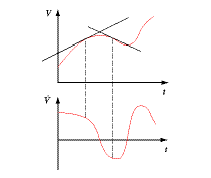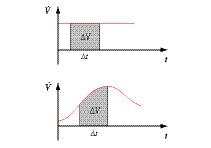1. Quantities and Mathematical Operations | |

| |
Primitives Primitives are terms or quantities that cannot be defined on the basis of other quantities. They are fundamental and are taken from everyday notions and mental images of what we see happening around us. Quantity of fluid stored. There are three possible measures of amounts of fluids stored in systems: Volume, mass, and amount of substance. The volume of liquids is chosen to measure their amount. In processes, the volume of a liquid stored is a function of time (Figure 1). The unit of volume is m^3. We use the symbol V to denote the volume of a fluid stored in a system. Mass and amount of substance are related to volume:  1.1 1.1
m is its mass measured in kg, rho is the density, and n stands for amount of substance (unit: mole). Mo is the molar mass of the substance. | |
Volume current. The volume current (or volume flux, or simply flow) describes the flow of a fluid through pipes or other channels. The current allows us to calculate how much fluid is transported in a given period of time. The unit of volume current is m^3/s. We use the symbol IV to denote a flow of fluid, i.e., a volume current. In processes, the flow is a function of time (Figure 2). | |
Pressure. The pressure measures the state of the fluid which is directly responsible for hydraulic processes. Its unit is Pa (Pascal), the symbol used is p. 10^5 Pa equals one bar (1 bar). The pressure at the bottom of a 10 m high column of water here on Earth is about 1 bar. So is the average air pressure at sea level. | |
Derived quantities Change of volume. The change of volume over a period of time is defined as the difference between the later and the earlier values:  1.2 1.2
The change of volumes can be read from graphs (on the vertical axis) and from tables, or it can be calculated from formal representations of the functions. Rate of change of volume. The rate of change of volume describes how fast the volume stored changes (Figure 1). Symbols are dV/dt or V with a dot above it (pronounced V-dot). The unit of rate of change is m^3/s. The rate of change is determined graphically from the slope of tangents at points of the curve in the volume-time diagram. | |
Transported volume. (Figure 2, symbol Ve). Graphically, the transported volume corresponds to areas between the function IV(t) and the time axis for an interval of time from, say, t1 to t2 (integration):  1.3 1.3
| |
From rate of change of volume to volume. The mathematical procedure is that of integration, in this case of the rate of change of volume over time (Figure 3):  1.4 1.4
| |
From rate of change of volume to volume (continued). If we also know the initial value of the volume, we can calculate the volume as a function of time (Figure 1). This can be done graphically or numerically (in a spread sheet, or with the help of a system dynamics tool). | |
Pressure difference. The pressure difference is the difference of pressures in a fluid at two different points A and B, independent of the physical reasons for the pressure difference. Usually, it is defined as downstream value minus upstream value, or simply later minus earlier in a chosen direction:  1.5 1.5
| |



 1.3
1.3
 1.4
1.4
